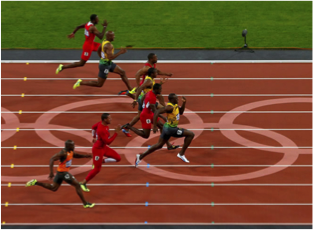1. CONCEPT.
It is the physical skill that allows
us to perform movement in the minimum possible time.
Speed can be manifested in several ways: such
as the distance covered in a given time (movement speed), stimulus reaction
(reaction speed) or performance gesture (gesture speed).
2. FACTORS DETERMINING SPEED.
They can be divided into two main
groups:
- Muscle factor:
- Muscle fibre length and resistance.
- Muscle fibre structure: there two type of muscle fibre in all muscle, the red or type I (active for long periods) and the white type or type II (quick and for short time)
- Muscle elongation.
- Muscle mass.
- The nervous system, which transmit the impulse from peripheral receptors to the brain.
- Weight and muscle size.
- Age.
- Nutrition.
3. TYPES OF SPEED
Reaction speed: It is the skill used to respond to a given stimulus in the shortest
possible time, for example, a goalkeeper’s save or the starting shot of a 100-meter
race.
-
The
reaction speed depends on various factors, which include:
-
The
type of stimulus: visual, auditory, tactile…
-
The
number of organs and sensory receptors stimulated.
-
The
intensity an duration of the stimulus.
-
The
speed of transmission of the nerve impulse.
-
Age
and gender.
-
Concentration
level.
-
The
degree of training.
Movement speed: It is the skill used to cover a distance in the shortest possible time,
for example, 100 meter swimming.
In this type of speed,
there is movement of the whole body through continuous repetition of motor
actions.
Gesture speed:
It is the skill used to perform movement with one part of the body in the
shortest possible time, for example, in a shot al goal in handball or a
backhand in tennis. This is also called segmental, execution or action speed…
It is characterised by an isolation gesture, which is repeated only once
4. SPEED TRAINING SYSTEMS
To improve
your movement speed you should increase your muscle power, and remember that
POWER = SPEED x STRENGTH. That is why, to be quicker, you must train not just
speed but also force.
- Some
of the most usual systems are:
o
FLAT RACES – repetitions of short distances to train general speed.
o
MULTIJUMPS – you will improve your muscular explosive strength.
o
UPHILL SPRINTING – to train power.
o
DOWNHILL SPRINTING – to train “overspeed”, so that you will improve your nervous system and
coordination.




No hay comentarios:
Publicar un comentario